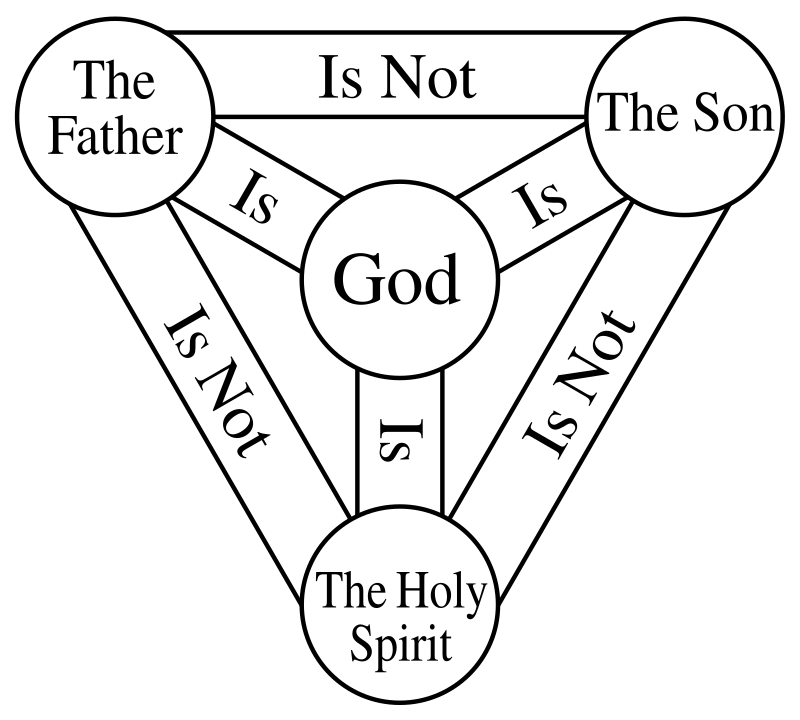Problems with the Trinity Shield
The "Trinity Shield", or "Shield of the Trinity" presented below, is a very popular diagram used to represent the main claims of the doctrine of the Trinity:

In contemporary Trinitarian apologetics, it is used to represent the following list of seven claims:
- There is one God
- The Father is God
- The Son is God
- The Spirit is God
- The Father is not the Son
- The Son is not the Spirit
- The Spirit is not the Father
These seven claims - whether accompanied by the Shield, or not - are often presented when a Unitarian points out that the doctrine of the Trinity is not explicitly taught in the Bible. The purpose in presenting them is to argue that while Trinitarianism may not be explicitly taught in the Bible, these seven claims are each clearly taught, and their only rational implication is that God is Triune.
This is also often used in an attempt to simplify the doctrine, for teaching purposes, as it reduces what is an extremely complex doctrine into seven easy-to-understand claims.
Problems with the Seven-Claim Trinity
The Trinity theory taught by the Trinity Shield, when analyzed, runs into several problems. Firstly, the seven claims, as written above, violate a basic, uncontroversial implication of the law of identity - the transitivity of identity. If a=b, and b=c, then by the transitivity of identity, a=c, that is, a must be c. So, if points #2-4 are true, then points #5-7 are demonstrably false, because if "the Father is God" (a=x) and "Jesus is God" (b=x) then the Father just is Jesus (a=b).
Additionally, the seven claims do not allow one to say "God is Triune", by the same rule. If God is triune, then points #2-4 necessarily mean that the Father, Son, and Holy Spirit are each triune, also by the transitivity of identity. To affirm "God is triune", and "Jesus is God", means that Jesus either must be triune, or He is not God.
So, points #2-4 simply do not work. They need to be rephrased, and qualified, in order to avoid demonstrably contradicting points #5-7, and the proposition that God is triune. Points #2-4 would need to be changed, so that, for instance, instead of saying "Jesus is God", the claim would now say, "Jesus is one of three Persons within God". However, such a claim is suddenly not easy or simple to prove from Scripture at all, as such a thing is definitely not explicitly taught in the Bible. So, the seven claims lose their simple appeal, if the necessary revisions are undertaken to make them not self-contradictory.
In addition, the Trinity Shield is missing several key aspects of almost all formulations of the doctrine of the Trinity. It is missing the doctrine of the eternal generation of the Son and Spirit, taught in the Nicene-Constantinopolitan Creed. It is missing the common assertion that each of the Persons work inseparably together, or that they all share one will, or mind. Or, for the Trinity theories which do not hold to these more classical views, it is missing their alternatives. It is missing the assertion that the three Persons are co-equal and co-eternal - which cannot just be assumed, as some early theologians, who even may have called Jesus "God", and said that He shared the same Essence as the Father, maintained a subordinationist Christology.
Finally, points #2-7 seem to imply that point #1 - there is one God - is false. By breaking the doctrine of the Trinity into these seven points, it is apparently hoped that even if #1 does not seem possible to reconcile with #2-7, somehow, it must be, because the Bible is supposed to teach all seven. However, if one were to conclude that the Bible teaches all seven points, it still would not get rid of the problem of apparent incoherence. The tension that something does not quite add up in this system remains, even if one thinks that the Bible teaches all seven points. And, the attempt to reconcile points #2-7 with #1 is where nearly all of the traditional complexity of the doctrine of the Trinity lies in the first place. So, breaking the doctrine into these points has not actually gotten rid of the complexity needed to maintain a coherent view of God in the system, it has just pushed it to later steps, which are not pictured in the diagram.
Conclusion
Aside from the Unitarian disagreement with the doctrinal content of some of the points in the Trinity Shield diagram, the Trinity Shield also falters in that it appears to make identity statements which are self-contradictory, it lacks too much doctrinal content to be considered a representation of the doctrine of the Trinity, and it appears to teach the inconsistent claims that there is one God, and three Gods, the reconciliation of which has traditionally been the source of the complexity that the diagram attempts to avoid.